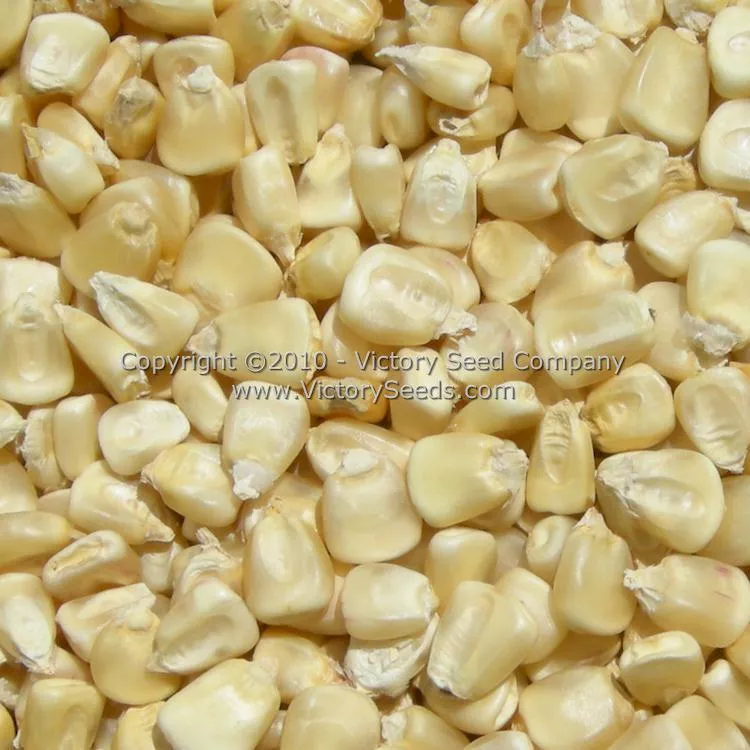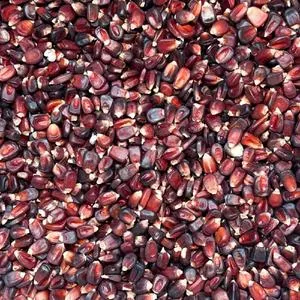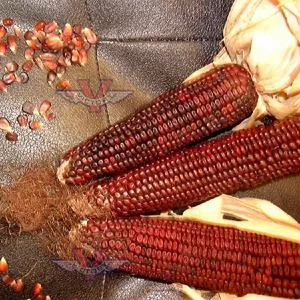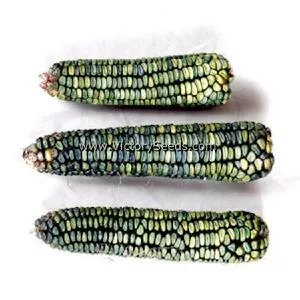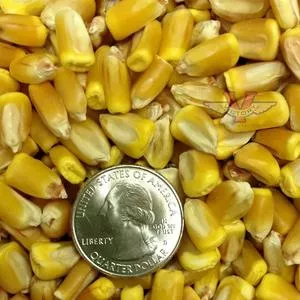Boone County White Dent Corn
Zea mays subsp. mays
Price: $3.33
SKU: 31402011Choose a variant:
115 days - 'Boone County White' was once one of the most popular white dent corn varieties grown in the corn belt. A heavy producer with huge ears, it was always winning prizes at corn shows.[1] It grows large (ten to twelve inch) ears with eighteen to twenty four rows of deep, pure white kernels on huge (ten to twelve foot), leafy plants. It makes a good fodder crop.
'Boone County White' dent corn was developed by selection from an old variety of corn known as 'White Mastodon' by Mr. James W. Riley, of Boone County, Indiana. 'White Mastodon' corn, grown quite extensively in the latter part of the 19th century in southern Indiana, was a large, coarse, late-maturing variety. Mr. Riley made his first selections in 1876, choosing the earlier maturing ears with white cobs. This selected seed was then planted in a separate field and developed over a period of years by continued selection and stabilization, without crossing with any other variety.[3] After several years of this work he gave his new type of corn the name 'Boone County White.'[2]
'Boone County White' dent corn was developed by selection from an old variety of corn known as 'White Mastodon' by Mr. James W. Riley, of Boone County, Indiana. 'White Mastodon' corn, grown quite extensively in the latter part of the 19th century in southern Indiana, was a large, coarse, late-maturing variety. Mr. Riley made his first selections in 1876, choosing the earlier maturing ears with white cobs. This selected seed was then planted in a separate field and developed over a period of years by continued selection and stabilization, without crossing with any other variety.[3] After several years of this work he gave his new type of corn the name 'Boone County White.'[2]
Genetic Classification: Open Pollinated
Planting Instructions:
Soil must be at least 65ºF to germinate. Be patient and do not plant too early or you will waste a lot of seed! Plant in full sun and keep it watered. Corn is a wind-pollinated plant. Plant in blocks several rows wide to ensure full ears.
Sow seeds about 1½ to 2½ inch deep, 3 to 4 inches apart, in rows spaced 24 to 30 inches apart. Thin to 6 to 12 inches apart.
Harvest Information:
Pick the ears for dry grain or decoration when the husks are dry and the kernels are hard enough that you cannot make a dent in them with your fingernail. Many people pick the ears too early when kernels are still soft. If this is done they shrivel up and shrink and their beauty is destroyed. They cannot finish maturing once they have been picked.
Even though the ears look dry, there remains moisture deep within the cob. If you were to enclose them in a box, the moisture would cause them to sour and mold. You may let them dry longer on the plants if neither weather nor predators are damaging them. Otherwise hang them up or lay them out in the open until they are completely dry inside.
Sow seeds about 1½ to 2½ inch deep, 3 to 4 inches apart, in rows spaced 24 to 30 inches apart. Thin to 6 to 12 inches apart.
Harvest Information:
Pick the ears for dry grain or decoration when the husks are dry and the kernels are hard enough that you cannot make a dent in them with your fingernail. Many people pick the ears too early when kernels are still soft. If this is done they shrivel up and shrink and their beauty is destroyed. They cannot finish maturing once they have been picked.
Even though the ears look dry, there remains moisture deep within the cob. If you were to enclose them in a box, the moisture would cause them to sour and mold. You may let them dry longer on the plants if neither weather nor predators are damaging them. Otherwise hang them up or lay them out in the open until they are completely dry inside.
Informational References:
- "Variety Tests" - Circular 6, Kansas A. E. S., 1910.
- "The Book of Corn: A Complete Treatise Upon the Culture, Marketing and Uses of Maize in America and Elsewhere," edited by Herbert Myrick, Orange Judd Company, 1913.
- "Corn," Kansas State Agricultural Experiment Station, Bulletin 193, Manhattan, Kansas, December, 1913.
- Note: Little appears to be known of the origin of the Mastodon corn. It was probably closely related to 'St. Charles White' corn, developed in southern Missouri.
- "James W. Riley," A Portrait and Biographical Record of Boone, Clinton and Hendricks Counties, Indiana, A.W. Bowen, Chicago, 1895, page 422.
Customer Reviews:
Do you have experience with this one? 📝 📣 Write a review!
No reviews have been posted yet.

